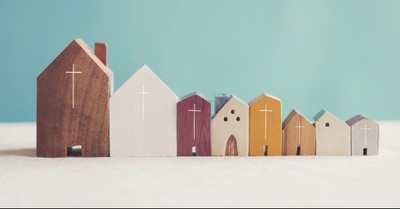What Marie Kondo Doesn't Tell You about 'Tidying Up'
- Carrie Dedrick
- Updated Feb 01, 2023

Like millions of other Americans, I recently finished watching all eight episodes of Netflix's Tidying Up with Marie Kondo. And then I started going through closets, dressers, and cabinets in my house. Items started disappearing. And as they disappeared, my smile grew bigger and my soul felt more at peace.
It’s a phenomenon and it’s sweeping the nation.
If you haven’t yet watched the series (or read her book), Marie Kondo is a Japanese “tidying” expert. She specializes in helping others part with excess items for a minimalist lifestyle. Once items are pared down to essentials, Kondo assists with organization, demonstrating how best to display and store the things we need.
This process is not new. But the KonMari method is unique. She simply asks people, “Does this item spark joy for you?”
That’s it. If an item does not spark in the owner a feeling of joy, out it goes (and, it is important to note that “out” usually means donated to a charity, not thrown away).
In the Netflix series, we watch a variety of people go through the process of releasing items that don't spark joy for them. A young married couple with small children, newlyweds combining belongings, a couple expecting a baby, and a woman who recently lost her husband are some of the people featured on the show. Each household and situation is unique, just as the occupants are unique. This sends the viewer a message that all types of people can benefit from a tidier, streamlined space.
According to the KonMari method, one must go through the process of releasing items in five categories of the home:
- Clothing
- Books
- Paper
- Komono (kitchen, bathroom, miscellaneous)
- Sentimental Items
We watch as Kondo helps her clients with the emotions attached to items in the home. Sometimes a person clings to a belonging and we never see Kondo argue with the person’s choice to keep it. It seems that minimalism isn't the point of the KonMari method. She focuses more on creating an organized environment filled with just the things that make the individual happy.
Here are some of my observations about the show:
The practice of "greeting" the house may seem strange at first, but we should try it.
When Kondo first enters a home and meets its occupants, she then "greets" the house. She kneels on the floor, closes her eyes, brushes her hands across the floor, and silently thanks it for protecting those who live there from harsh weather. Now, I’m not saying we need to do this exactly, but what if we took a few seconds a day to be thankful for our home?
So many people struggle with housing insecurity and homelessness. The fact that we have a place to call home is an incredible blessing, and one that we probably don't think about every day. When you enter your home, "greet" it with gratitude. Thank God for the walls that surround you and protect your family from the wind, and the roof that blocks the rain and snow. Then pray for those without a home. Pray that the homeless would find protection from the elements that day and secure permanent housing in the long term so they, too, may be safe and warm.
Gratitude is at the heart of the KonMari method.
There is more to the KonMari method than throwing all of your clothing into a pile on the bed, picking out the pieces that spark joy, and stuffing the rest into donation bags. Truth be told, we could do just that and end up with a tidier house, but a crucial piece of the process would be missing: gratitude.
This is what I love most about Tidying Up and the KonMari method. When someone decides to part ways with one of their belongings, Kondo tells them to thank the item for its service while it was in the owner’s possession. For example, a person who decides to let go of a pair of running shoes could say, "Thank you for helping to keep me healthy and active." Gratitude is truly at the heart of what Kondo teaches.
Similar to remembering to be thankful for our homes, it would do us well to be grateful for what is inside them. Take a stroll around your house and look at its contents. We have beds to sleep in complete with sheets and blankets, pots and pans to cook our meals and plates and silverware to eat them with, clothes to wear, couches and chairs to sit on, games to play, movies to watch, toys for our children to play with, and the list goes on and on. Our needs are met, as are many of our wants. The KonMari method teaches us contentment as we learn to accept that what we have is enough.
Overconsumption and materialism are the root of our problems.
Every person featured on Tidying Up has one thing in common: their homes are overstuffed with stuff. They have more than what they need. I am not casting judgment; I struggle with this as well. Many of us do.
Shopping is fun. Walking out of a store with something new is exhilarating. It makes us feel good to wear a new shirt that brings out our eyes or to buy a flattering dress. But that new item loses its appeal after a few wears. Expert marketers convince us that we need the next new thing. So we go back for more and more. The cycle never ends.
Many people feel overwhelmed in their homes. Entering the house doesn’t bring a sense of peace; it brings a feeling of drowning in excess. We don’t know how things got to this point, but we recognize that something is wrong. Some people will even combat this feeling by buying more to have that exhilarated feeling of having something new again.
Overconsumption is what happened here. We bought more than what we needed. And now we're drowning in the aftermath.
Shopping can become an addiction, as much as smoking, drinking, doing drugs, gambling, viewing pornography, and overeating. Something inside us craves more and we shop to satisfy that need - that's materialism. Unfortunately, we are only temporarily satisfied. The addiction urges us to buy again and again.
The KonMari method can help us pare down to the essentials, but it won't stop us from bringing more stuff into our homes afterward. What Kondo fails to mention is that the open space we create by purging items is not meant to be restocked with new things. It should remain open.
It's a contentment issue.
If you struggle with the feeling that you need more, what you're wrestling with is contentment. There is only one thing that will leave you feeling whole and that's Jesus. Turn to Scripture for understanding:
“But godliness with contentment is great gain. For we brought nothing into the world, and we can take nothing out of it. But if we have food and clothing, we will be content with that. People who want to get rich fall into temptation and a trap and into many foolish and harmful desires that plunge men into ruin and destruction. For the love of money is a root of all kinds of evil. Some people, eager for money, have wandered from the faith and pierced themselves with many griefs. But you, man of God, flee from all this, and pursue righteousness, godliness, faith, love, endurance and gentleness. Fight the good fight of the faith. Take hold of the eternal life to which you were called when you made your good confession in the presence of many witnesses.” (1 Timothy 6:6-12)
These verses are telling us to stop pursuing earthly treasure and seek God’s Kingdom instead. Love the Lord. Serve the Lord by serving his people. Stop hoarding stuff in our houses and start asking God what he would have us do with our excess. It’s time to be satisfied with the homes we have and the belongings inside them. We don’t need more. We already have more than what we deserve in the gift of eternal life.
Cut up your credit cards if you have to. If Internet shopping is your vice, get rid of the Internet in your house. Time has run out for excuses. Now is the time to accept that the void in your heart you’ve filled with meaningless stuff was really meant for Jesus.
Marie Kondo is wrong about joy.
Marie Kondo is inspiring so many people to let go of tangible things in pursuit of open space, organization, and joy. I did it, and cannot deny that my heart feels lighter knowing that my excess will benefit another person, while I have breathing room in my closets and drawers. But if we think that is the end of the process, we are mistaken.
The end comes when we understand that true joy comes from Christ. Material things can make us happy, and it’s okay to keep them. But joy is different than happiness.
Perhaps that is why we see several people on the show struggle with the “joy” concept. Kondo assures clients that they will know when an item sparks joy because they will feel a “ting” of excitement and warmth. Not everybody gets it at first (though they seem to understand this idea later on).
If we look at this with a biblical perspective, we see things differently. It shouldn’t surprise us that some people don’t understand what clothing, books, papers, komono, and sentimental items spark joy because none of them do. A comfortable shirt can make us happy. Looking at wedding photos certainly bring back loving memories. But these feelings are not joy.
Joy has something that happiness does not: Jesus. Happiness is temporary but joy is eternal; it’s a state of being, not an emotion. Joy is anchored in Christ and cannot be swayed by worldly circumstances. It is the knowledge that no matter what life throws at us our, our hope remains in the Savior.
Consider these Scriptures:
“You will make known to me the path of life; In Your presence is fullness of joy; In Your right hand there are pleasures forever.” (Psalm 16:11)
“For the kingdom of God is not a matter of eating and drinking, but of righteousness, peace and joy in the Holy Spirit.” (Romans 14:17)
When the Bible talks about joy, it is so much more than a “ting” that we feel because we really like a pair of fuzzy socks. It is a holy connection to Jesus Christ in our hearts.
There is nothing wrong with cleaning out your homes. By all means, donate the items that no longer serve you to a worthy cause. But do so with the understanding that a tidy house is not going to bring you joy. Joy only comes through faith in Lord Jesus.
“Though you have not seen him, you love him; and even though you do not see him now, you believe in him and are filled with an inexpressible and glorious joy, for you are receiving the end result of your faith, the salvation of your souls.” (1 Peter 1:8-9)
Carrie Dedrick. Being a wife and mom of a toddler keeps her busy, but in her free time, she enjoys running long distances and going to local baseball games with her adopted dogs. Follow her writing on marriage and motherhood at Basic Millennial Mama.
Photo courtesy: ©Getty Images/shironosov




















